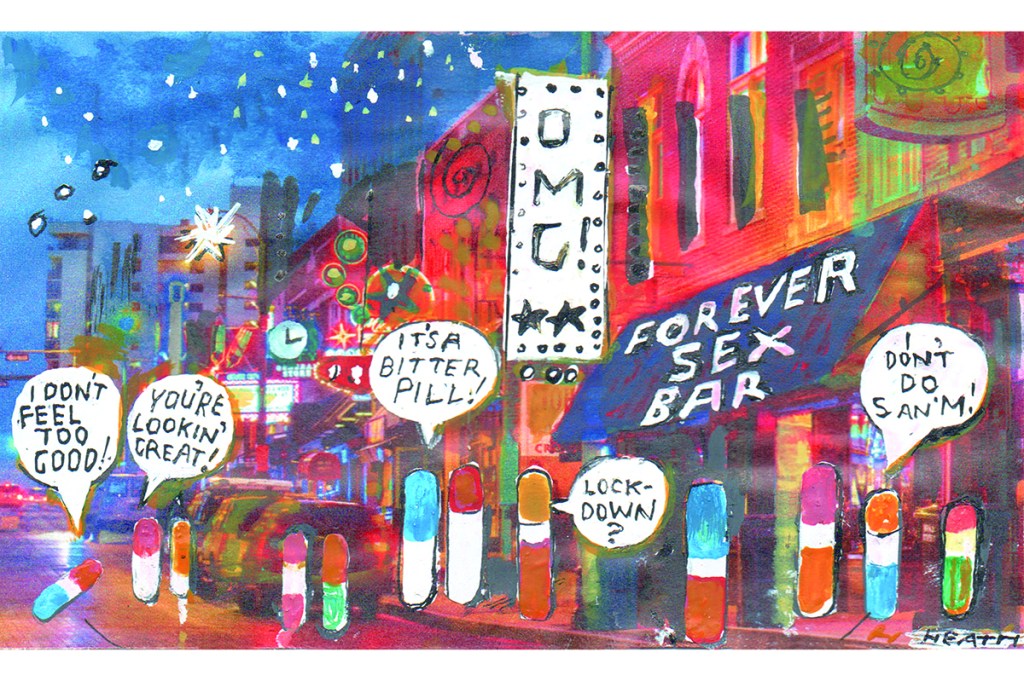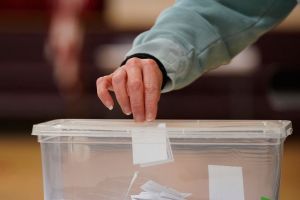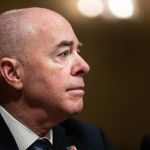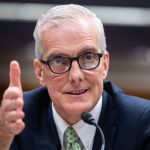In your thirties, they come for you. A rogue’s gallery of rail-thin torsos, floppy hair and chubby cheeks infiltrates your inbox with their conspicuous mating call: hey daddy.
In the homosexual subculture this tribe is known as the twinks — sparkly-eyed, aggressively youthful gay men usually under the age of 25. Twinks range from painfully shy to overly effeminate and hypersexual. In the bars, or the sandy gay ghettos of Provincetown or Fire Island, they tend to be pack hunters. Online, they are solitary predators with an eye on that slightly older, more accomplished and self-assured man. They confess to the unsuspecting daddies that they are ‘an old soul’ and ‘hate people my own age’.
Twinks have always been around, but I’ve noticed something disturbing that lurks beneath the puppy-faced Snapchat filters of today’s youth. There’s a level of sexual depravity that makes even an old gay whore like me clutch my pearls. There are certain things, at 21, you just shouldn’t know about, let alone beg for. Worse still, where I might expect the longing for companionship, I find only malevolent nothingness.
Unless you’re old, or already at death’s door, coronavirus is not much to be afraid of and will be a memory by this time next year. Aids, however, is still technically a pandemic. My first memory of Aids came when I was eight or nine, playing on the concrete with a garter snake I caught on the banks of the swamp just off the highway. When you’re a kid playing on the sidewalk you’ll notice cement is made up of many colored specks and that some of those granules, the fiery red ones, are moving.
When I heard ‘Aids’ as a child I thought it was the plural of a small organism, like a germ, called an Aid. It sounded like they were everywhere. I knew they were red because people wore red ribbons and whenever the word appeared in the box next to the newscaster’s head, it was always in red letters.
Aids killed people, like my friend’s dad, but not all people, only homosexuals, who, although I’d never met one, I understood were a sort of embarrassment. I also suspected I was very likely to be one of these ignominies and if I didn’t already have Aids, I would soon. That must be what these little red bugs — most likely clover mites, in reality — were.
It became a game to search for a square of sidewalk with no Aids crawling around on it but at night I’d sometimes cry in bed thinking they’d sooner or later get me. When I was 15, I got my first HIV test. Some nights that year, after everyone was asleep, I put my mother’s car into neutral, rolled it down the driveway, and a few yards up the street started the engine a safe distance away from the house, and drove downtown to the gay bar where I sneaked inside through a service door. You had to wait two weeks for the results of an HIV test back then; rapid testing wouldn’t come along for many years. And after two agonizing weeks, each time when you were called in for your results and the door opened and the doctor finally appeared with his clipboard, the world collapsed into a singularity.
For so many of us that has been one of life’s unchanging rituals, every six months, until very recently. HIV has been on Donald Trump’s mind. At a briefing from the Oval Office on May 1, Daniel O’Day, CEO of pharmaceutical giant Gilead, stood next to the President to announce that his company was distributing more than one million doses of Remdesivir, a drug thought to help COVID-19 patients, to hospitals around the country. Scarf icon and White House coronavirus response coordinator Dr Deborah Birx stood nearby and the discussion soon turned to HIV. Birx built her reputation on HIV. She was appointed by Obama to head up the ambassador-level role of US global Aids coordinator. She is known to compare the fight against COVID-19 to HIV.
‘I lost a lot of friends through HIV, it was terrible,’ Trump said during the briefing. ‘I’m someone from New York who lost a lot of friends to Aids, a tremendous amount of friends, some of the most talented people I knew, I lost to Aids.’ Among those friends was an early mentor to a young Donald Trump, Roy Cohn, the ruthless attorney and political fixer who had been Sen. Joseph McCarthy’s chief counsel. Cohn played a major role in McCarthy’s anti-communist hearings of the 1950s. In popular culture, Aids lore and the homosexual media, Cohn continues to be portrayed as one of the Aids era’s top villains, rivaled only by Ronald Reagan, despite dying from the disease himself.
During the briefing in May, Trump reiterated a promise made during his last State of the Union address. ‘We will be Aids free in eight years, working with Gilead.’ In 2012, the Food and Drug Administration approved Truvada, a drug made by Gilead to treat HIV-positive patients, for use as a pre-exposure prophylaxis, or PrEP. The pill, according to some researchers, has 97 percent effectiveness at preventing HIV when taken daily. Think of it as birth control for gays, and in late 2019 the Trump administration worked out a deal with Gilead to get free PrEP for more than 200,000 Americans considered at high risk for contracting HIV.
In America’s gay enclaves, PrEP is more than just the law of the land. Any skepticism about the drug’s impact on society is met with clamorous backfire from LGBT activists, matched in resolve only by their dead silence over President Trump’s embrace of it. From 2014 to 2017, use of PrEP among gay men in the US soared 500 percent. Today, more than a third of at-risk gay men are on the drug and it’s far from cheap. A one-month supply costs nearly $2,000 at list price. Then there are the doctor’s bills: users are told to visit the doctor four times a year to test for sexually transmitted diseases and to check liver and kidney functioning. These costs are passed on to insurance companies, community health centers, nonprofits and, in big cities, taxpayers. It’s another way Aids continues to be great business not only for charities but drug companies. HIV medications account for roughly 67 percent of Gilead’s revenue; the company raked in $14.6 billion from HIV drugs alone in 2018.
A current, and feeble, backlash against PrEP is unlikely to take hold. Gilead faces a class action lawsuit claiming PrEP causes kidney failure and bone density loss, leading to fractures and osteoporosis. Syphilis, gonorrhea and chlamydia reached an all-time high in the US in 2018. While the Centers for Disease Control (CDC) claimed the causes of the STD explosion to be varied, even citing ‘poverty, stigma and unstable housing’, PrEP may well be a big factor. Ask anyone: gay men — society’s steadfast disease vectors — simply don’t use condoms as much anymore.
The US market is a test kitchen for drug companies and PrEP is no different. Today about 575,000 people across the globe take the drug as a preventative measure, with the vast majority of them, 225,000, in the United States. Roughly 190,000 of the remaining users are primarily in sub-Saharan Africa, namely adolescent girls and young women in Kenya, South Africa, Uganda, and Zimbabwe, who take the drug as part of research studies by non-governmental organizations. Europe’s socialized healthcare systems have largely refused to pay for the staggering costs associated with PrEP. The continent has only around 62,000 users, mostly in England, France and Germany.
The CDC wants to see an increase in those numbers, claiming that only 10 percent of Americans who need PrEP are on it. An absurd marketing campaign in New York City has targeted women to get on the drug, with entire subway cars plastered in advertisements. They all seem to suggest you can’t trust that your man isn’t sneaking around with other men on the side. The World Health Organization endorses a lifelong dependency on Truvada for the masses. But its goal of three million daily users worldwide by this year fell far short.
Aids charity bigwigs, perhaps fearing the impending dissolution of an empire of the sickly, have been some of the most persistent PrEP-skeptics. Among them are Larry Kramer, the face of Aids activism in the 1980s, and Michael Weinstein, CEO of the world’s largest Aids non-profit, the Aids Healthcare Foundation, who called the drug a ‘boutique intervention’ and rightly pointed out that the CDC has almost entirely abandoned recommending condom use as a preventative measure in order to focus on PrEP.
PrEP’s most staunch adherents are familiar with the boutique economy. They tend to be rich, coastal gays. Another term for the regimen might be ‘party drug’. In spite of PrEP, new HIV infections in the US have remained stable since 2010, at about 38,000 a year, according to the CDC, with 69 percent of those being black and Latino men.
Fear of Aids, in many ways, brought us together. As anyone over 30 remembers, condoms are no fun. If you wanted an enjoyable, worry-free sex life you had no choice but to settle down with someone. People my age remember the ritual of meeting someone new and, after several weeks of monogamy, going to get tested together. It was something to look forward to and it was also more likely to keep you faithful. When something scary lurks outside, what you have next to you becomes more sacred and worth protecting. When I think of my friends in their fifties and sixties, each one is alive today only because they stuck with committed relationships when everyone around them was dying of Aids.
You won’t find many Aids charities, activists or PrEP peddlers fretting too much about the societal and spiritual ramifications of unlimited, consequence-free sex but the chickens are already coming home to roost for many straight people. The novelty of instant, anonymous sex — a culture the straights appropriated from the gays when they discovered location-based hookup apps like Tinder — has worn off. ‘I’ve never thought of women as complete bitches until Tinder,’ a friend once said to me. ‘It’s horrifying how mean and dismissive they can be based on one photo.’
Women’s happiness has steadily plunged since the sexual revolution and the invention of birth control pills, a state intensified by instant sex on the internet. Scientists have known for some time that, thanks to the brain chemical dopamine, sex can be just as addictive as drugs or alcohol. Dopamine is the feel-good chemical that rewards us after we experience something thrilling. But it’s also value-neutral, meaning it doesn’t distinguish between positive and negative behavior.
During sex, oxytocin is released in the brain of women and vasopressin in men. Both chemicals aid in forming bonds with others. Oxytocin is released when women breastfeed and vasopressin when men play with their kids. Those chemicals are also the reason breakups are so painful. In their book Hooked: New Science on How Casual Sex Is Affecting Our Children, researchers Joe McIlhaney and Freda Bush discuss the rampant emotional corrosion resulting from so much casual sex. ‘Every time a person has sexual intercourse or intimate physical contact, bonding takes place… There is evidence that when this sex/bonding/breaking-up cycle is repeated a few or any times — even when the bonding was short-lived — damage is done to the important, built-in ability to develop significant and meaningful connection to other human beings.’
During the COVID-19 lockdown many of us see that medical tyranny often isn’t the sadistic face of Nurse Ratched but a cool and detached academic brought forth from the ivory tower and given far too much dominion over society for someone who’s considered little else than germs and numbers for the past 30 years. If the idea of PrEP is to safeguard human life, it instead seems to be ensuring the slow death of the most sacred thing in life — companionship and intimacy. In Aldous Huxley’s Brave New World, promiscuity is not only encouraged but law under the totalitarian World State government. Emotional attachment and monogamy are illegal and the sexual urge must be satisfied publicly and instantly. We aren’t exactly living in that world but we aren’t far off.
‘Like, when did “piggy slut” become such a thing on the dating apps?’ my friend Andrew said recently. We met in a gay bar a few months ago and bonded over the topic of PrEP destroying relationships. ‘Bareback sex was such a big deal in the early 2000s, because you would only do that with someone you were in a relationship with, because of the danger,’ he said. ‘I definitely think there is a cultural difference with gay people pre-PrEP and pre-apps. The apps destroyed everything. If you have the option to sleep around and have sex all the time, are you going to settle down anymore?
The answer is no. Because there are too many options out there and there’s no risk. Gay culture has gone so far left they don’t even believe in traditional relationships anymore. These young kids are all in open relationships and that destroys you. Being intimate and monogamous is better for your self-esteem and self-worth, but the gay community teaches the opposite.’
***
A print and digital subscription to The Spectator is just $7.99 a month
***
Gay marriage was sold to the American people using conservative arguments of commitment and family values, but that disappeared fast, particularly as drag queens began barnstorming kindergarten classes and academics called for medically sterilizing children. ‘Love is love’ morphed into an assault against love. Everyone seems to forget that love and passion are great acts of discrimination. The opposite leaves a numb, oversexed, depraved mono-citizenry — which may be entirely the point.
There is, of course, the other obvious concern. You can’t catch Aids from a doorknob, or even a kiss. It is, and always has been, 100 percent preventable by way of personal lifestyle choices — save for early on, when the blood supply became tainted. But with the rate that gay men freely exchange fluid, now more than ever thanks to PrEP, and jet around the globe, what if the next death sentence bug isn’t so confined to the sexual choices of men? We’ve already seen that happening in one of PrEP’s epicenters, New York City.
In two weeks in 2013 a deadly penicillin-resistant bacterial meningitis outbreak killed seven gay men and hospitalized 22 others. That year, meningitis cases in New York were 60 times higher for gay men than straights. The strain was believed to have originated in the Los Angeles gay community and had medical experts baffled. Five years later, in 2018, the meningitis outbreak resurfaced in New York’s gay community. Even then, as the health department scrambled to contain the outbreak, and the mysterious illness targeting gay men conjured memories of the early days of Aids, media outlets warned against stigmatizing homosexuals. After a 33-year-old lawyer died during the 2013 outbreak a week after developing symptoms, a spokesperson for the family cautioned against speculating over any risqué activities he may have been involved in. ‘This is not a gay disease, but this is a deadly disease’, she said.
Happy Pride month, everyone.
This article is in The Spectator’s June 2020 US edition.


















